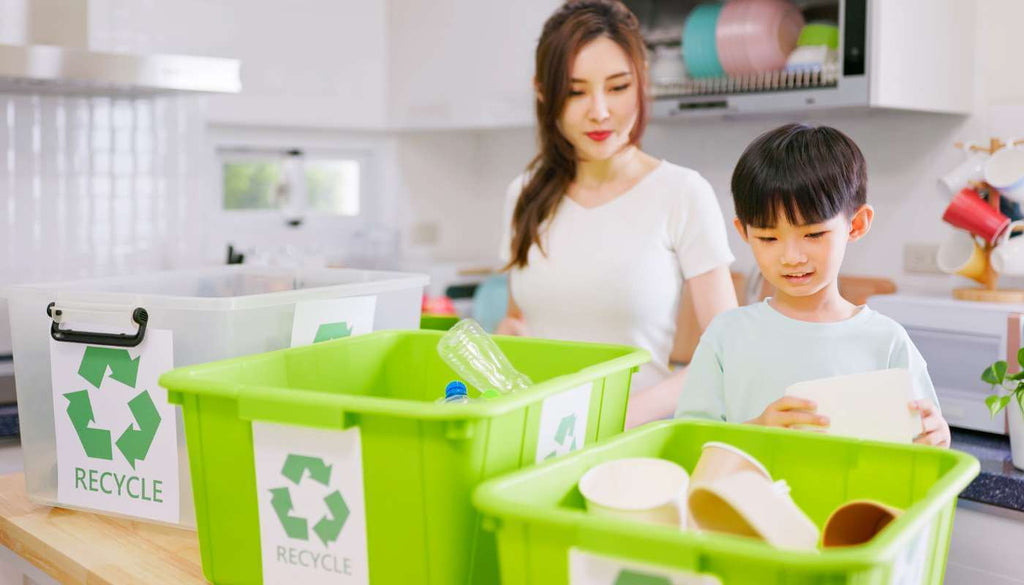
Sustainability for Kids: How to Raise Them with the Environment in Mind
If you're reading this blog post, you probably think about the environment and sustainability fairly regularly. But although you're aware of the environment and your impact on it, how do you teach sustainability for kids? How do you get them to care about what's going on around them, and to be a positive force for change in the world?

How do you explain sustainability to kids?
The first step is getting your kids to understand what sustainability means. And of course, how you explain it depends on how old your children are. At a basic level, something is sustainable if you can use it and it's easy to replace. Let's say you pick a dandelion. Another one will grow back pretty quickly, so that's sustainable. But if you cut a tree down, it grows back slowly, so it's not quite as sustainable. And if you take this rock out of the ground and throw it away, you're not going to get another rock in that place. So that's not sustainable. We want children to understand that we want to have enough of the things that we need, forever. That's stuff like good food, clean water, green environments and clean air to breathe.
Sustainability for kids: The basics
There are lots of tips for teaching your kids how to care for the environment. Simple things can have a big impact.
Refuse. Reduce. Reuse. Repurpose. Recycle.
- Start early by saying no to things like disposable straws, or single use water bottles.
- Seek out good quality toys that have multiple ways to play with them, rather than poor quality plastic ones that soon lose their charm.
- Give your kids gifts of experiences, instead of toys or stuff.
- Don’t use plastic and disposables if you can help it. Start early by packing snacks and lunches at home, in reusable containers.
- Get kids involved in separating out the garbage for recycling.
- Use recycled objects to create fun games.
- Repurpose stuff that's no longer useful and turn it into something else. One of my kids' favourites was using old clothes to make wheat bags for winter bed warmers!
- Talk to kids about how things like balloons might be fun for a short time, but they're really bad for the environment and animals for a long time.
- Teach them to switch off the lights when they leave the room.
- When they’re brushing their teeth, teach them to turn the water off when they’re not using it.
- Walk, bike or take public transport whenever you can. It’s better for your health and the environment!
- Pick up the rubbish you see when you’re out on your walks. You can make it a fun game when the kids are young, and by the time they’re older it’s a habit.
As always when it comes to raising children, and it's no different when teaching kids about sustainability: they do what you do, not what you say. Model the behaviour you want them to adopt, and start as young as you can.
Read more: How To Recycle Just About Anything
Open the discussion with your kids about sustainability
Talk to your kids about what they can do to help the environment. Encourage them to come up with ideas of their own. They’ll probably come up with some harebrained schemes (at least at first), but take them seriously and implement what you can. You can read them books like Charlie and Lola: We Are Extremely Very Good Recyclers or I Want to Go Green! But What Does That Mean? to get them started. Tell them about the consequences of pollution and runaway consumption. For example, if you live near the ocean and see a plastic bag by the side of the road, you can explain how that plastic bag might end up in the water and hurt wildlife.
Create an emotional connection with nature
When it comes to learning how to bring up your kids to care for the environment, the best thing you can do is teach them how to care about nature on an emotional level. When children are raised seeing the beauty and wonder of nature they’re more likely to want to protect it. An afternoon spent catching and releasing tadpoles down at the creek is worth more than any number of lectures in some stuffy classroom somewhere. The research backs up this approach, too. Take your kids out in nature whenever you can. Go camping with them. Even if you live in the city you can always find some nature. Take them to the park and point out how the trees are all different and how pretty the flowers are.
